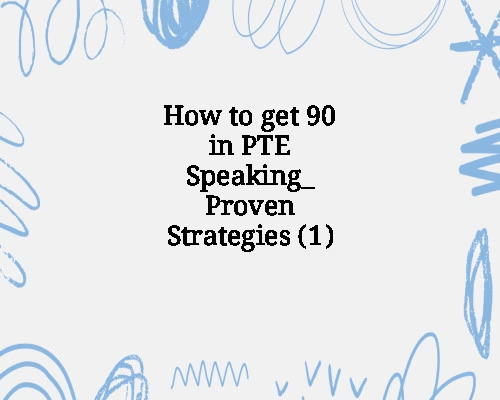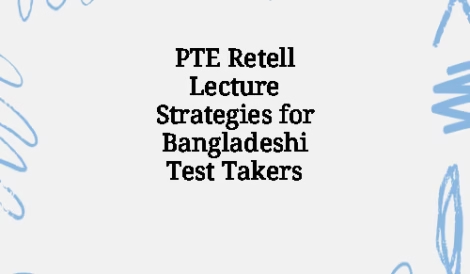How to get 90 in PTE Speaking_ Proven Strategies (1)
How to Get 90 in PTE Speaking: Proven Strategies
Master proven strategies and task-specific techniques to score a perfect 90 in PTE Speaking, no matter your accent or background.
Introduction to the PTE Speaking Module
The PTE Academic Speaking section assesses your ability to communicate effectively in academic English. This module consists of five core tasks:
-
Read Aloud
-
Repeat Sentence
-
Describe Image
-
Retell Lecture
-
Answer Short Question
Each task contributes to your overall speaking score, but some also influence other areas like reading and listening. Achieving a 90 requires a combination of pronunciation clarity, fluency, vocabulary range, and understanding of the scoring algorithm.
Understand How PTE Speaking Is Scored
Pearson uses an AI scoring system that evaluates your performance in three key areas:
-
Content: Relevance and completeness of your response
-
Pronunciation: Clarity of speech and how native-like it sounds
-
Oral Fluency: Smoothness and pace of delivery without hesitations or false starts
You must deliver content accurately and fluently with intelligible pronunciation to maximize your score.
General Strategies for a 90 in PTE Speaking
1. Perfect Your Oral Fluency
Fluency does not mean speaking fast. It means speaking naturally with proper pace, rhythm, and intonation. Avoid:
-
Repetition of words
-
Long pauses
-
Filler words like uh, um, you know
Instead:
-
Practice speaking in phrases, not individual words
-
Use apps like ELSA Speak or shadow podcasts to improve your fluency
2. Improve Pronunciation
Clear pronunciation is critical. You don’t need a native accent, but your words must be easily understood by the AI.
-
Record yourself and compare with native speakers
-
Work on stress and intonation
-
Use online tools like Google Speech Recognition to check intelligibility
3. Stick to the Format
Each speaking task has a structure. Following this structure helps you remain fluent and relevant. Learn and internalize these templates.
4. Practice With Real Exam Software
Use platforms that simulate real PTE test environments like APEUni, E2Language, or PTE Tutorials. This builds comfort with the timing and interface.
Task-Specific Strategies
Read Aloud
This task impacts both your speaking and reading scores.
Tips:
-
Break sentences into chunks or phrases
-
Stress key content words (nouns, verbs, adjectives)
-
Don’t rush—use a medium pace
-
Emphasize intonation at sentence ends (falling tone for statements)
Practice Strategy:
Use a stopwatch and practice 10–15 academic texts daily. Record and listen to your delivery.
Repeat Sentence
Arguably the most scoring task in Speaking, it affects speaking, listening, and fluency.
Tips:
-
Don’t try to memorize every word—focus on meaning and rhythm
-
Use chunking technique to group words while listening
-
Immediately repeat without pause
-
If you miss part of the sentence, repeat what you remember fluently
Practice Strategy:
Use YouTube playlists of repeat sentence practice and apps like PTE.Tools. Train your memory to retain 8–12 word sentences.
Describe Image
This task tests your ability to describe visual information.
Tips:
-
Use a structured response: introduction → main features → conclusion
-
Don’t panic if you don’t understand the image completely—describe visible trends or patterns
-
Speak for the entire 40 seconds
Template Example:
“The image is a [type of image] showing [general description]. The main feature is [describe trend/data]. Overall, the image illustrates that…”
Practice Strategy:
Practice describing 10 images daily with different graphs, charts, maps, and photos. Time yourself strictly.
Retell Lecture
You’ll hear a lecture and must summarize it in 40 seconds. This affects speaking, listening, and content.
Tips:
-
Take structured notes using symbols and keywords, not full sentences
-
Start with a brief introduction
-
Focus on main idea, supporting points, and examples
-
Use fillers only if fluent (e.g., “Let me tell you about…”)
Template Example:
“The lecture was about [topic]. The speaker mentioned that… He also explained… In conclusion, the lecture highlighted…”
Practice Strategy:
Listen to TED Talks or BBC Learning English and summarize them in 40 seconds using a similar format.
Answer Short Question
Simple but score-sensitive, this task evaluates listening and general knowledge.
Tips:
-
Listen actively and respond within 3 seconds
-
Provide one-word or short answers
-
If unsure, give your best logical guess
Practice Strategy:
Go through high-frequency question banks. Aim to answer 50–100 short questions over a few days to build reflexive speed.
Accent and the AI: Should You Be Worried?
No. The AI scoring system is designed to handle a variety of accents. What matters is clarity and intelligibility, not mimicry of a native accent.
Focus on:
-
Avoiding mother tongue interference
-
Using correct stress patterns
-
Not swallowing endings of words
Use tools like Google Docs voice typing to see if your spoken responses are recognized correctly.
The Importance of Mock Tests
Doing 10–15 full-length speaking mocks under timed conditions is essential for:
-
Reducing anxiety
-
Improving speed and delivery
-
Evaluating consistency
Always review recordings of your responses. Note where you pause, stammer, or mispronounce and work on those weak areas.
Daily Practice Plan (30 Days to 90)
| Day | Focus Area |
|---|---|
| 1–7 | Read Aloud + Repeat Sentence |
| 8–14 | Describe Image + Retell Lecture |
| 15–20 | Full Speaking Test Simulation |
| 21–25 | Analyze Mistakes + Improve Weak Spots |
| 26–30 | Mock Tests + Real-Time Practice |
Each day, aim for:
-
30 minutes of task-specific practice
-
15 minutes of pronunciation drills
-
1 full mock every 2–3 days from Day 15 onward
Additional Tools for Excellence
Apps & Platforms:
-
PTE.Tools: Extensive practice questions
-
APEUni App: AI scoring and templates
-
E2 Test Prep: High-quality videos and real test simulations
-
Google Docs Voice Typing: Test your speech clarity
YouTube Channels:
-
Jay from E2Language
-
Swish English
-
Alpha PTE
Conclusion: Your 90 Is Within Reach
Getting 90 in PTE Speaking isn’t about having a native accent or perfect vocabulary. It’s about consistent technique, task familiarity, and smart practice. Focus on structure, fluency, and clear pronunciation. Use AI tools and mock tests to measure progress, and polish your skills using feedback loops.
If you build confidence through strategy and repetition, a perfect speaking score is absolutely attainable—regardless of where you’re from or how you speak.





